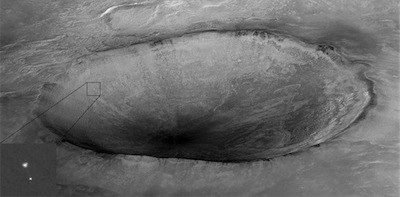
That inset image is the Phoenix Lander descending. It's not heading into the "Heimdall" crater but is landing about 12 miles in front of it.
Phoenix will be looking below the surface of Mars. Universe Today explains what it's looking for:

"This pair of images...shows the similarities between the surface of Mars where Phoenix landed (top) and permafrost on northeastern Spitsbergen, Svalbard (bottom) an archipelago in the Arctic Ocean north of mainland Europe, about midway between Norway and the North Pole. The polygon patterns in the permafrost form when the upper parts of the ground thaw and refreeze from season to season. The ground contracts in the winter cold, creating small spaces that fill with melted water in the summer. When winter returns and the water freezes, it acts like a wedge, enlarging the cracks."
"And why is this so interesting? On Earth, permafrost, glaciers, and other frozen environments can preserve organic molecules, bacteria, and fungi for hundreds of thousands, even millions, of years. The Phoenix spacecraft has scientific instruments that will dig into the frozen ground of the Martian Arctic, vaporize the soil sample, and analyze the chemistry of the vapors. Scientists hope to learn whether ice just below the surface ever thaws and whether some chemical ingredients of life are preserved in the icy soil."
No comments:
Post a Comment